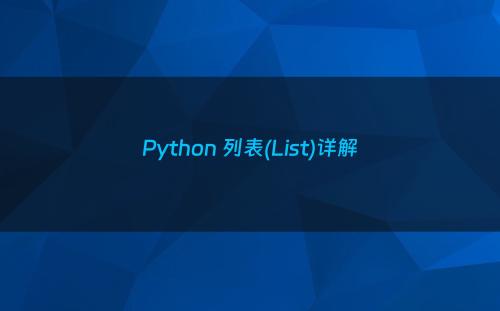网站首页 > 基础教程 正文
列表是 Python 中最基本、最常用的数据结构之一,它是一个有序的、可变的元素集合。
一、列表的基本操作
1. 创建列表
# 空列表
empty_list = []
empty_list = list()
# 包含元素的列表
numbers = [1, 2, 3, 4, 5]
fruits = ['apple', 'banana', 'orange']
mixed = [1, 'hello', 3.14, True]
# 使用list()构造函数
list_from_string = list('Python') # ['P', 'y', 't', 'h', 'o', 'n']
list_from_range = list(range(5)) # [0, 1, 2, 3, 4]2. 访问列表元素
fruits = ['apple', 'banana', 'orange', 'grape']
# 正索引访问(从0开始)
print(fruits[0]) # 'apple'
print(fruits[2]) # 'orange'
# 负索引访问(从-1开始)
print(fruits[-1]) # 'grape'
print(fruits[-3]) # 'banana'
# 切片操作 [start:end:step]
print(fruits[1:3]) # ['banana', 'orange']
print(fruits[:2]) # ['apple', 'banana']
print(fruits[::2]) # ['apple', 'orange'] (步长为2)
print(fruits[::-1]) # ['grape', 'orange', 'banana', 'apple'] (反转列表)3. 修改列表
fruits = ['apple', 'banana', 'orange']
# 修改单个元素
fruits[1] = 'pear'
print(fruits) # ['apple', 'pear', 'orange']
# 修改切片
fruits[1:3] = ['grape', 'kiwi']
print(fruits) # ['apple', 'grape', 'kiwi']
# 添加单个元素
fruits.append('melon')
print(fruits) # ['apple', 'grape', 'kiwi', 'melon']
# 添加多个元素
fruits.extend(['peach', 'berry'])
print(fruits) # ['apple', 'grape', 'kiwi', 'melon', 'peach', 'berry']二、列表常用方法
1. 添加元素
nums = [1, 2, 3]
# append() - 在末尾添加单个元素
nums.append(4) # [1, 2, 3, 4]
# extend() - 添加多个元素(合并列表)
nums.extend([5, 6]) # [1, 2, 3, 4, 5, 6]
# insert() - 在指定位置插入元素
nums.insert(0, 0) # [0, 1, 2, 3, 4, 5, 6]2. 删除元素
nums = [0, 1, 2, 3, 4, 5, 6, 3]
# remove() - 删除第一个匹配的元素
nums.remove(3) # [0, 1, 2, 4, 5, 6, 3]
# pop() - 删除并返回指定位置的元素(默认最后一个)
last = nums.pop() # 返回3, nums变为[0, 1, 2, 4, 5, 6]
second = nums.pop(1) # 返回1, nums变为[0, 2, 4, 5, 6]
# del语句 - 删除指定位置或切片
del nums[0] # [2, 4, 5, 6]
del nums[1:3] # [2, 6]
# clear() - 清空列表
nums.clear() # []3. 查找和统计
letters = ['a', 'b', 'c', 'a', 'd', 'a']
# index() - 返回元素的第一个匹配位置
print(letters.index('a')) # 0
print(letters.index('a', 1)) # 3 (从位置1开始查找)
# count() - 统计元素出现次数
print(letters.count('a')) # 3
print(letters.count('x')) # 0
# in操作符 - 检查元素是否存在
print('b' in letters) # True
print('x' in letters) # False4. 排序和反转
nums = [3, 1, 4, 1, 5, 9, 2]
# sort() - 原地排序
nums.sort() # [1, 1, 2, 3, 4, 5, 9]
nums.sort(reverse=True) # [9, 5, 4, 3, 2, 1, 1]
# sorted() - 返回新排序列表(不改变原列表)
sorted_nums = sorted(nums) # [1, 1, 2, 3, 4, 5, 9]
# reverse() - 原地反转列表
nums.reverse() # [9, 5, 4, 3, 2, 1, 1] -> [1, 1, 2, 3, 4, 5, 9]三、列表的高级操作
1. 列表推导式
# 创建平方数列表
squares = [x**2 for x in range(10)]
# [0, 1, 4, 9, 16, 25, 36, 49, 64, 81]
# 带条件的列表推导式
even_squares = [x**2 for x in range(10) if x % 2 == 0]
# [0, 4, 16, 36, 64]
# 嵌套列表推导式
matrix = [[1, 2, 3], [4, 5, 6], [7, 8, 9]]
flattened = [num for row in matrix for num in row]
# [1, 2, 3, 4, 5, 6, 7, 8, 9]2. 列表复制
original = [1, 2, 3]
# 浅拷贝(三种方式)
copy1 = original.copy()
copy2 = list(original)
copy3 = original[:]
# 深拷贝(用于嵌套列表)
import copy
nested = [[1, 2], [3, 4]]
deep_copy = copy.deepcopy(nested)3. 列表与字符串转换
# 字符串转列表
s = "hello"
char_list = list(s) # ['h', 'e', 'l', 'l', 'o']
# 列表转字符串
words = ['Python', 'is', 'great']
sentence = ' '.join(words) # "Python is great"四、列表性能考虑
- 时间复杂度:
- 索引访问:O(1)
- 末尾追加/删除:O(1)
- 中间插入/删除:O(n)
- 查找元素:O(n)
- 选择合适的数据结构:
- 频繁在首部插入/删除:考虑 collections.deque
- 频繁查找/去重:考虑 set 或 dict
- 不可变序列:考虑 tuple
五、实际应用示例
# 示例1:处理成绩数据
grades = [85, 90, 78, 92, 88]
# 计算平均分
average = sum(grades) / len(grades)
# 找出高于平均分的成绩
above_avg = [g for g in grades if g > average]
# 示例2:矩阵转置
matrix = [[1, 2, 3], [4, 5, 6], [7, 8, 9]]
transpose = [[row[i] for row in matrix] for i in range(3)]
# [[1, 4, 7], [2, 5, 8], [3, 6, 9]]列表是 Python 中最灵活的数据结构之一,掌握它的各种操作和特性对于编写高效、清晰的 Python 代码至关重要。

猜你喜欢
- 2025-04-27 102.Python——字典和列表排序
- 2025-04-27 年近半百自学Python之列表元素的排序操作
- 2025-04-27 Python基础教程:在Python中访问列表元素详解
- 2025-04-27 python入门-day6-列表
- 2025-04-27 python入门到精通教程06-一文轻松搞懂python列表
- 2025-04-27 Python 中的列表用法详解
- 2025-04-27 零起点Python机器学习快速入门-4-4-列表操作
- 2025-04-27 Python 列表高级操作指南
- 2025-04-27 Python 列表实用操作大全
- 2025-04-27 Python列表操作速查表
- 最近发表
- 标签列表
-
- 菜鸟教程 (58)
- jsp (69)
- c++教程 (58)
- pythonlist (60)
- gitpush (78)
- gitreset (66)
- pythonif (68)
- pythonifelse (59)
- deletesql (62)
- c++模板 (62)
- c#event (59)
- linuxgzip (68)
- 字符串连接 (73)
- nginx配置文件详解 (61)
- html标签 (69)
- c++初始化列表 (64)
- exec命令 (59)
- canvasfilltext (58)
- mysqlinnodbmyisam区别 (63)
- arraylistadd (66)
- node教程 (59)
- console.table (62)
- mysqldatesub函数 (63)
- window10java环境变量设置 (66)
- c++虚函数和纯虚函数的区别 (66)
